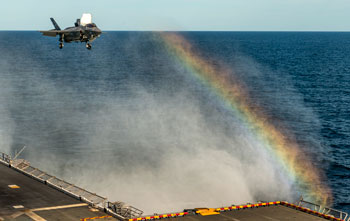INDIAN ARMED FORCES CHIEFS ON OUR RELENTLESS AND FOCUSED PUBLISHING EFFORTS

The insightful articles, inspiring narrations and analytical perspectives presented by the Editorial Team, establish an alluring connect with the reader. My compliments and best wishes to SP Guide Publications.

"Over the past 60 years, the growth of SP Guide Publications has mirrored the rising stature of Indian Navy. Its well-researched and informative magazines on Defence and Aerospace sector have served to shape an educated opinion of our military personnel, policy makers and the public alike. I wish SP's Publication team continued success, fair winds and following seas in all future endeavour!"

Since, its inception in 1964, SP Guide Publications has consistently demonstrated commitment to high-quality journalism in the aerospace and defence sectors, earning a well-deserved reputation as Asia's largest media house in this domain. I wish SP Guide Publications continued success in its pursuit of excellence.
- Indian Air Force Aims for Full Indigenous Inventory by 2047 — Air Chief Marshal A.P. Singh
- General Upendra Dwivedi takes over as the Chief of the Army Staff
- Rajnath Singh assumes charge as Defence Minister for the second consecutive term
- Admiral Dinesh K. Tripathi assumes Command of the Indian Navy as 26th Chief of the Naval Staff
- Prime Minister witnesses 'Bharat Shakti' – a Tri-Services Firing and Manoeuvre Exercise in Pokhran, Rajasthan
F-35 Lightning II programme surpasses 10,000 flight hours

The Lockheed Martin F-35 Lightning II programme continues its operational maturation, surpassing 10,000 flight hours in September. More than half of the total hours were accumulated in just the past 11 months. Through September, F-35s flew 6,492 times for a total of 10,077 flight hours. The new milestone effectively doubles the safe flight operations of the F-35 in a year, compared to reaching 5,000 flight hours in six years.
This milestone was achieved by operational production aircraft operating at Eglin Air Force Base, Florida, and Marine Corps Air Station Yuma, Arizona, where F-35 pilots and aircraft maintainers conduct training and the combined F-35 system development and demonstration (SDD) and operational test (OT) aircraft operating at Edwards AFB, California, Naval Air Station Patuxent River, Maryland, and Nellis AFB, Nevada. All three variants: the F-35A conventional takeoff and landing (CTOL), the F-35B short takeoff/vertical landing (STOVL), and the F-35C carrier variant (CV) participated in the programme milestone.
The F-35 Lightning II is a fifth generation fighter, combining advanced stealth with fighter speed and agility, fully fused sensor information, network-enabled operations and advanced sustainment. Three distinct variants of the F-35 will replace the A-10 and F-16 for the US Air Force, the F/A-18 for the US Navy, the F/A-18 and AV-8B Harrier for the US Marine Corps, and a variety of fighters for at least 10 other countries.





